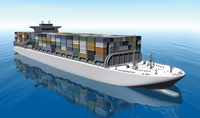
Lead Image © jager, 123RF.com
VMware connections to the Kubernetes market
Supertanker
Admins understand that simply operating containers is not enough. Instead, purpose-designed container orchestration is also necessary, which is where the popular Docker was seen to be lacking. Google's Kubernetes jumped into the breach and developed a busy life of its own far removed from Docker.
For decades, VMware was the industry leader in virtualization, offering a virtualization environment from a single source. VMware vSphere, the server virtualization platform, easily docks with other VMware products and has even jumped on the OpenStack bandwagon with a kind of translation component between the official OpenStack APIs and vSphere in the form of VIO – VMware Integrated OpenStack.
It was strange for VMware to have seemingly been asleep through most of the Kubernetes hype. Ultimately, Kubernetes with its containers in the background – no matter which run time they use – are tantamount to a central attack on the core of VMware's business (i.e., full virtualization and paravirtualization).
Sleeping on the Kubernetes threat is now a thing of the past: Project Tanzu is about to become the VMware toolkit for Kubernetes, claiming to integrate Kubernetes seamlessly with the existing VMware framework.
Some of the tools used in Tanzu are already available under an open source license; further components will follow in the coming months. It's worth taking a closer look. What are VMware's tactics with regard to Kubernetes? What can VMware users expect when it comes to Kubernetes? Where does VMware's love of container orchestration end?
Integration Is Not Easy
Even if it looks to be so at first glance, it is not easy for VMware to integrate Kubernetes and possible additional programs into its own portfolio. After all, Kubernetes (also called K8s) seems to do very well without real virtualizers like VMware or KVM – that's one of the software's core
...Buy this article as PDF
(incl. VAT)
Buy ADMIN Magazine
Subscribe to our ADMIN Newsletters
Subscribe to our Linux Newsletters
Find Linux and Open Source Jobs
Most Popular
Support Our Work
ADMIN content is made possible with support from readers like you. Please consider contributing when you've found an article to be beneficial.




